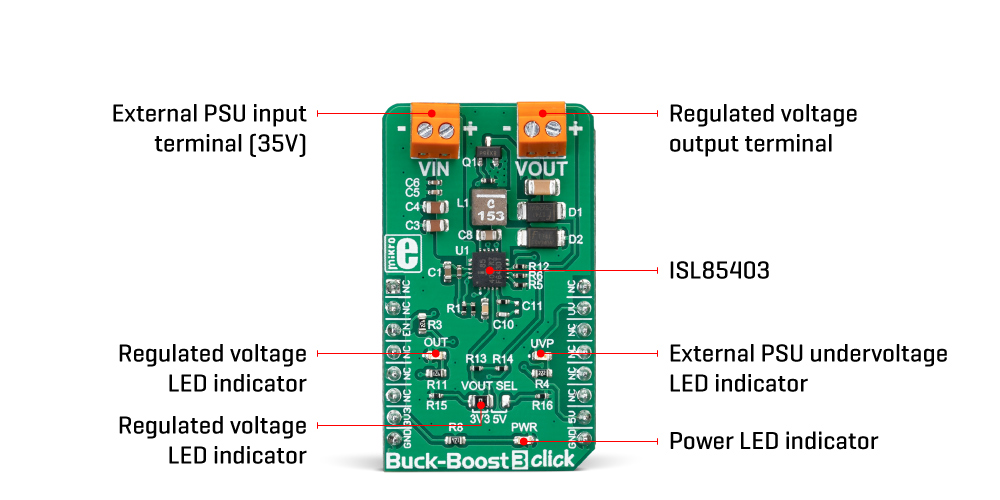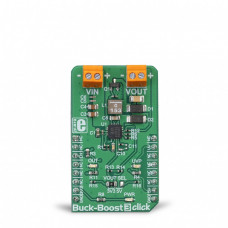Buck-Boost 3 Click
This device is capable of providing reasonably high current on the output. The frequency of the internal PWM oscillator is 500kHz, which ensures an optimal efficiency-to-size ratio. Buck-Boost 3 click offers a very tight output voltage regulation, reliable overcurrent protection, it allows a wide voltage range on the input terminal and can operate in both PWM/PFM modes, allowing optimized efficiency for the connected load.
Featuring both buck and boost functionality on one device, while maintaining an accurate voltage at the output, even with heavier loads, this Click board™ can be used to provide continuous power in cases when the input voltage fluctuates a lot, in the range from 2.5V up to 35V.
How does it work?
The Buck-Boost 3 click is based on the ISL85403, a 2.5A regulator with the integrated high-side MOSFET and a low-side driver, by Renesas, allowing it to be used in different topologies. Buck-Boost 3 click uses the single inductor buck-boost topology, allowing it to maintain the selected 3.3V or 5V on the output, regardless of the input voltage. The input voltage can vary between about 2.5V and 35V. This makes the Click board™ suitable to be used as the battery power regulator, for example, compensating for the voltage drop, while maintaining the constant voltage at the output, necessary for the embedded system.

The ISL85403 offers two modes of operation: PWM and PFM. These modes are switched automatically depending on the current through the MOSFET, ensuring an optimal efficiency for both light and heavier loads at the output. The PFM (Pulse Frequency Modulation) mode allows the ISL85403 to be more efficient when there is a light load connected at the output. In this case, the frequency of the PWM oscillator can be dramatically reduced since the stored inductor energy is depleted much slower by the connected load. Although more efficient for light loads, the PFM mode results in a slightly higher output voltage ripple. This makes the PFM mode well suited for situations when the connected device enters the hibernation or sleep mode. Buck-Boost 3 click has a resistor which sets the device to operate in PWM mode until the current through the MOSFET drops under 0.4A.
The maximum output current depends on many external factors, mostly on heat dissipation, but also on the duty cycle of the internal PWM oscillator, as well as the input voltage. Since the Buck-Boost 3 click uses a synchronous switching model with the external low-side MOSFET, the heat dissipation is somewhat lowered, but it still depends on the input voltage and the duty cycle. The ISL85403 datasheet offers formulas which can be used to calculate the specific duty cycle for a certain input and output voltages, as well as the current through the inductor. Once these values are known, the maximum current available for the load can be calculated, having in mind that the inductor current is limited to about 2.75A, by the resistor connected between the ILIM pin of the ISL85403 and GND.
The output voltage can be selected by positioning the SMD jumper labeled as VOUT SEL to either 3V3 or 5V position. This jumper is used to select one of two resistor values for the FB pin of the ISL85403 IC. Values of these resistors are calculated so that the Click board™ offers a selection between 3.3V and 5V. Most embedded applications use one of these two voltages, so these values are selected accordingly. The output voltage presence is indicated by a LED indicator, labeled as OUT on the Click board™. This indicator is not driven by the ISL85403; instead, this LED is supplied with power directly from the output terminal.
Following the idea of providing a regulated 3.3V or 5V on the output, the Click board™ is equipped with the Power Good LED indicator. When there is an undervoltage or overvoltage condition, this pin will be asserted to a LOW logic level, allowing the red LED indicator labeled as UVP to turn ON. The undervoltage condition indicates that the voltage at the FB pin has dropped below 90% of the reference value, while the overvoltage condition indicates that the voltage at the FB pin has risen above 110% of the reference value, which is 0.8V for the ISL85403 IC. The status of the LED indicator can also be read by the host MCU since the PGOOD pin of the ISL85403 IC is also routed to the INT pin of the mikroBUS™.
The Buck-Boost 3 click also features the EN pin, which is used to enable the ISL85403 IC. When there is a HIGH logic level on this pin, the buck-boost IC will be enabled. This pin is pulled to a HIGH logic level by an onboard resistor in case this pin is left floating. This pin is routed to the CS pin of the mikroBUS™, allowing the host MCU to control the Buck-Boost 3 click.
Specifications
| Type | Boost,Buck |
| Applications | Buck-Boost 3 click is perfectly suited to provide power with regulated voltage for embedded applications, points of load, or to be used as the battery voltage regulator, or in similar general-purpose power applications that require regulated 3.3V or 5V power supply. |
| On-board modules | ISL85403, a 2.5A regulator with the integrated high-side MOSFET, by Renesas |
| Key Features | High efficiency, wide range of input voltages, two most commonly used selectable regulated voltages at the output, overvoltage, undervoltage, and thermal protection, power good indication, output voltage indication, and more |
| Interface | GPIO |
| Compatibility | mikroBUS |
| Click board size | M (42.9 x 25.4 mm) |
Pinout diagram
This table shows how the pinout on the Buck-Boost 3 Click corresponds to the pinout on the mikroBUS™ socket (the latter shown in the two middle columns).
Onboard settings and indicators
| Label | Name | Default | Description |
|---|---|---|---|
| PWR | PWR | - | Power LED indicator |
| OUT | OUT | - | Regulated voltage LED indicator |
| UVP | UVP | - | Power good (under/overvoltage) LED indicator |
| TB1 | VIN | - | External power supply input terminal (35V max) |
| TB2 | VOUT | - | Regulated output voltage terminal (3.3V or 5V) |
| JP1 | VOUT SEL | Left | Regulated output voltage selection: left position 3.3V, right position 5V |
Software support
We provide a library for the Buck-Boost 3 click on our LibStock page, as well as a demo application (example), developed using MikroElektronika compilers. The demo can run on all the main MikroElektronika development boards.
Library Description
The library includes features to enable or disable devices and functions to check if the input voltage is below the operating voltage.
Key functions:
void buckboost3_enable(uint8_t state)- Function for enable/disable deviceuint8_t buckboost3_getInterruptState()- Function for get Intterupt pin state
Examples description
The application is composed of the three sections :
- System Initialization - Sets INT pin as INPUT and CS pin as OUTPUT
- Application Initialization - Initialization driver init and enable device
- Application Task - (code snippet) - It checks if the input voltage is below the operating voltage.
void applicationTask()
{
uint8_t PGOOD_state;
PGOOD_state = buckboost3_getInterruptState();
if (PGOOD_state == 0)
{
mikrobus_logWrite(" Low input voltage !!!", _LOG_LINE);
}
Delay_ms( 1000 );
}
The full application code, and ready to use projects can be found on our LibStock page.
Other mikroE Libraries used in the example:
GPIO
Additional notes and information
Depending on the development board you are using, you may need USB UART click, USB UART 2 click or RS232 click to connect to your PC, for development systems with no UART to USB interface available on the board. The terminal available in all MikroElektronika compilers, or any other terminal application of your choice, can be used to read the message.
mikroSDK
This click board is supported with mikroSDK - MikroElektronika Software Development Kit. To ensure proper operation of mikroSDK compliant click board demo applications, mikroSDK should be downloaded from the LibStock and installed for the compiler you are using.
For more information about mikroSDK, visit the official page.
Downloads
mikroBUS™ Standard specificationEnter the code in the box below:











